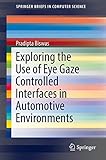Exploring the Use of Eye Gaze Controlled Interfaces in Automotive Environments [electronic resource] / by Pradipta Biswas.
By: Biswas, Pradipta [author.].
Contributor(s): SpringerLink (Online service).
Material type: BookSeries: SpringerBriefs in Computer Science: Publisher: Cham : Springer International Publishing : Imprint: Springer, 2016Description: XVI, 91 p. 70 illus., 64 illus. in color. online resource.Content type: text Media type: computer Carrier type: online resourceISBN: 9783319407098.Subject(s): Computer science | Special purpose computers | User interfaces (Computer systems) | Automotive engineering | Cognitive psychology | Computer Science | User Interfaces and Human Computer Interaction | Special Purpose and Application-Based Systems | Automotive Engineering | Cognitive PsychologyAdditional physical formats: Printed edition:: No titleDDC classification: 005.437 | 4.019 Online resources: Click here to access online
BookSeries: SpringerBriefs in Computer Science: Publisher: Cham : Springer International Publishing : Imprint: Springer, 2016Description: XVI, 91 p. 70 illus., 64 illus. in color. online resource.Content type: text Media type: computer Carrier type: online resourceISBN: 9783319407098.Subject(s): Computer science | Special purpose computers | User interfaces (Computer systems) | Automotive engineering | Cognitive psychology | Computer Science | User Interfaces and Human Computer Interaction | Special Purpose and Application-Based Systems | Automotive Engineering | Cognitive PsychologyAdditional physical formats: Printed edition:: No titleDDC classification: 005.437 | 4.019 Online resources: Click here to access online Preface -- Introduction -- Preliminary Studies on Input Modalities -- Intelligent Multimodal Systems -- User Studies on Driving Simulators -- Preliminary Studies on Cognitive Load Detection -- User Studies on Saccadic Intrusion -- Concluding Remarks.
This book provides a concise study of eye gaze tracking as a direct controller of electronic displays and interfaces inside cars and other vehicles. The author explores the prospect of controlling a vehicle's internal system via the drivers' eye gaze and for the vehicles to analyse and respond to a drivers' change in cognitive load too. New algorithms tackling micro-saccadic eye movements and the inaccuracy in eye gaze tracking for controlling on-screen pointers are presented and explored. Multimodal fusion algorithms involving eye gaze and finger tracking systems are presented and validated and important results have been obtained on gaze controlled interfaces and visual responses whilst encountering oncoming road hazards. A set of user trials to validate the algorithms involving driving simulators are also presented by the author. Exploring the Use of Eye Gaze Controlled Interfaces in Automotive Environments would of great importance to researchers and designers alike, within the fields of automotive design and engineering, human-computer interaction (HCI) and intelligent interfaces.


There are no comments for this item.